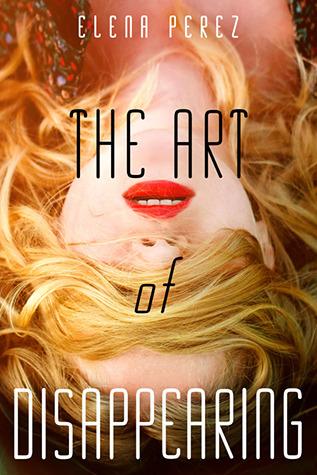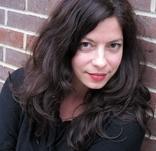
Book Chat is a special feature here in the blog that features and highlights authors and their books through an interview.
ABOUT THE BOOK

RELEASE DATE. July 17, 2012
PUBLISHER. Alloy Entertainment

SYNOPSIS.Delia can see the future … but can she change it?
All Delia wants is to be popular. She has the perfect plan: join the cheerleading squad with her best friend, Ava, and rule the school from the coolest table in the cafeteria. But everything changes the day she watches a boy die—before it actually happens.
After dreaming about a classmate’s demise, she’s shocked when she witnesses his last breath—just like she dreamed it. Ava insists Delia stop acting so strange, but Delia worries her abilities are beyond her control.
Torn between who she is and who she wants to be, Delia wishes she could simply disappear. She doesn’t get her wish, but when someone close to her vanishes, Delia must use her gift to solve the mystery, before it’s too late.
The Art of Disappearing by Elena Perez by alloyentertainment

ABOUT THE AUTHOR. Born and raised in New Jersey, Elena Perez discovered a love for writing early on and was often crafting poems and stories. The author went on to major in English as an undergrad and was then awarded a graduate fellowship in Creative Writing from Temple University. Today Elena lives and writes on NYC’s Lower East Side with her boyfriend (also a writer) and her dog (who prefers naps to writing).
Why did you write The Art of Disappearing?
Well, there’s the simple, kind of cliché fact that I feel like I have to write as, well, an extension of breathing. So that had something to do with it! But I decided to write a novel—and particularly this novel—in a moment of clarity I had 38,000 feet in the air. (Yes, I was in an airplane.) I had been considering my history as a writer and while I had spent time in so many genres, including poetry, short stories, short film and lyrics, I realized I hadn’t yet written a novel. It was always part of the plan, but I had put it off because I was … scared.
As I’m staring out at the wing of the airplane, it’s sinking in that writing a novel would be a truly terrifying pursuit and that if I tried to do it and failed, I would no doubt hate myself forever and maybe even never write again. (Nothing like keeping the stakes low!)
The characters began as loosely based on my friends, but there’s not much of them left by the time you get to a final, published book. Still—they’re in there. It’s always fun to listen to them debate which one of them is which character in my books!
So I decided I better get started immediately. And I did, right there on the plane.
Of course everything I wrote during that flight was fairly horrible and didn’t make the cut for the final project. But you have to start somewhere, right?
Elena, in writing The Art of Disappearing, where did you start? Where did you find inspiration for the characters or the story?
The first thing I had to work with in The Art of Disappearing, besides complete trepidation, was Delia Dark, the protagonist. Her name came to me in an instant and in that same instant I knew who she was: a young girl trying to find her path but struggling with a blurry and maybe misplaced identity. I knew she started out in a comfortable place—isn’t that usually the moment life throws its curves at us? And I knew that something major would happen to force her to look more deeply into her own identity. That something turned out to be two things—the witnessing of her classmate’s death and the realization that she dreamed about it the night before. I had to make sure her world was totally shaken up.
Because so much of The Art of Disappearing is about a girl figuring out who she is, the other characters emerged based on their position in the same journey. For example, Ava, Delia’s best friend, seems to know herself all too well. She has a plan to be a star cheerleader and she is so vigilant about it that she drags Delia along for the ride—or tries to, at least, until things fall completely apart. Trisha, the other friend in their trio, is more like Delia; she seems to be satisfied with tagging along with Ava but, when Delia goes off course, so does Trish. It’s like there’s a ripple effect of change that’s triggered by that one terribly tragic moment in the beginning.
Did you do a lot of research for this book?
The cool thing about writing about a psychic means that every time in my life that I had ever visited one suddenly qualifies as research. But one day in particular, when I had smashed into a merciless creative roadblock, I came across a reader in the East Village with a $5 dollar special. I stepped into that small little room with the small little table with tarot cards and crystals and a woman came out from behind a curtain. I was just a typical interruption as she kept house and cared for her kids. She instantly gave me the hard sell for the more expensive reading and was disgruntled when I stuck to the $5 special … . Of course, if you’ve read The Art of Disappearing, you might recognize some of this. My experience wasn’t as eventful as Delia’s visit to Linda, but when I got back to my machine, the words started flowing again.
What is it like being a novelist?
Well, first—I absolutely love that I get to answer that question! As I mentioned before, I had always planned to write novels so having achieved such a specific life goal makes me really, really happy. But that lasts for a few seconds and then it’s time to think about the next steps in my current project. That’s the work part of a novelist—you are your own source of discipline, so you have to do whatever you can to keep yourself focused.
But by far the best thing about a writer is being able to connect readers. As a teenager, I always had a novel in hand and even got up early so I could get some reading time in before school started. I seriously devoured books like some crazy-hungry bookworm, always looking out for the next great escape. Now I aspire to provide that same kind of nourishment for other hungry readers. And when I hear from someone who connected with The Art of Disappearing, I kind of explode inside. But in a good way, you know? With happiness.
Who are your favorite contemporary YA authors and why?
My favorite list is always changing as it’s built from the books I most recently enjoyed.
For instance, I read Rainbow Rowell’s Eleanor and Park this summer and it blew my mind. There’s something so exceptionally fresh in her approach—she captured a rawness of relationships in a way that had me clinging to every word. I’m so looking forward to reading more of her work.
Another great was Code Name Verity by Elizabeth Wein. I don’t really think of myself as a historical fiction fan, but yet I keep finding myself drawn to this time period. And Wein’s story about a young female spy in World War II had me hooked. It’s suspenseful and she gives us a unique, realistic take on what is a really wonderful trend of strong female characters. And the level of detail that Wein brought to the story is phenomenal.
Which of the characters in The Art of Disappearing do you most identify with and why?
Delia Dark, for sure. Sometimes I think I remember that period of life, that fourteen-going-on-ugh days, better than I remember last week. The story is certainly not autobiographical—and not just because I don’t think I’m psychic. But I can relate to the moment where you suddenly discover that you aren’t who you thought you might be, before you necessarily understand who you actually are. I think a lot of people can, though. Isn’t it kind of what happens when you’re growing up?
Which of the characters in The Art of Disappearing do you least identify with and why?
It would have to be Delia’s cousin Zach. Zach looks the way he wants to look, he listens to what he wants to listen to, he pursues knowledge beyond what’s given to him. He isn’t the type of person who will lose sleep thinking about who he is or how other people think about him. He’s very different from Delia in that he’s ‘science guy’ and Delia is driven more by emotion. Zach is probably the most level-headed character in all of The Art of Disappearing, and that includes the adults. I wish I were more like him.
Are there any issues related to adolescence that you are particularly passionate about? Are those issues addressed in The Art of Disappearing?
There’s a ton of emphasis on romance in YA, but I think equally—if not more—important are the relationships between friends. When you’re younger, you don’t really get to decide who you go to school with or where you live, so in many ways your choices of friends can be very limited. At the same time, it’s a critical time to build connections with people that have similar interests and can help lay the foundation for a strong and happy life. So, I think it’s safe to say that I think a lot about the role of friendship in these formative years. Delia’s story is interesting to me because she starts out on what is essentially the wrong path—she isn’t really meant to be a cheerleader or dwell in someone else’s shadow (Ava). Ultimately, she’s forced off the path because of who she is, deep down inside, even if she doesn’t realize it yet.
Another element is the importance of self-expression—as Delia’s world falls apart, she finds solace in her illustration. Creative pursuits—whether it’s writing, illustration, producing music, film, apps, etc.—can be such an important survival tool in adolescence and well beyond those years. It’s imperative that kids get the support they need to discover and connect with their own creative outlets.

